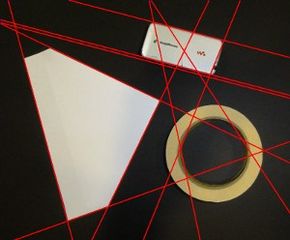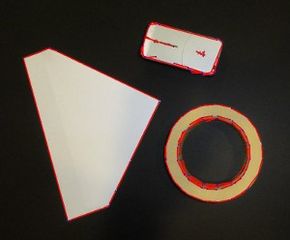Example Detect Lines
From BoofCV
Jump to navigationJump to searchLines are commonly found in man made environments. They can often be detected in location where other feature cannot due to the environments sparsity. Typical applications are for location targets and for evaluating the 3D structure of a building. Mathematically, a line has no end points and a line detector in BoofCV does not detect end points either. BoofCV does provide ways to detect line segments, which are lines with a beginning and end.
Line and line segment detection is still under development. No highly abstract and simplified interface is provided yet. Even though its under development still, these algorithms are still effective at detecting lines and line segments.
Example Code:
Concepts:
- Line detection
- Line segment detection
Relevant Examples:
Related Videos:
Example Code
public class ExampleLineDetection {
// adjusts edge threshold for identifying pixels belonging to a line
private static final float edgeThreshold = 25;
// adjust the maximum number of found lines in the image
private static final int maxLines = 10;
private static ListDisplayPanel listPanel = new ListDisplayPanel();
/**
* Detects lines inside the image using different types of Hough detectors
*
* @param buffered Input image.
* @param imageType Type of image processed by line detector.
*/
public static <T extends ImageGray<T>>
void detectLines( BufferedImage buffered, Class<T> imageType ) {
// convert the line into a single band image
T input = ConvertBufferedImage.convertFromSingle(buffered, null, imageType);
T blurred = input.createSameShape();
// Blur smooths out gradient and improves results
GBlurImageOps.gaussian(input, blurred, 0, 5, null);
// Detect edges of objects using gradient based hough detectors. If you have nice binary lines which are thin
// there's another type of hough detector available
DetectLine<T> detectorPolar = FactoryDetectLine.houghLinePolar(
new ConfigHoughGradient(maxLines), null, imageType);
DetectLine<T> detectorFoot = FactoryDetectLine.houghLineFoot(
new ConfigHoughGradient(maxLines), null, imageType);
DetectLine<T> detectorFootSub = FactoryDetectLine.houghLineFootSub(
new ConfigHoughFootSubimage(3, 8, 5, edgeThreshold, maxLines, 2, 2), imageType);
detectLines(buffered, blurred, detectorPolar, "Hough Polar");
detectLines(buffered, blurred, detectorFoot, "Hough Foot");
detectLines(buffered, blurred, detectorFootSub, "Hough Foot-Sub");
}
private static <T extends ImageGray<T>>
void detectLines( BufferedImage buffered, T gray, DetectLine<T> detector, String name ) {
List<LineParametric2D_F32> found = detector.detect(gray);
// display the results
ImageLinePanel gui = new ImageLinePanel();
gui.setImage(buffered);
gui.setLines(found);
gui.setPreferredSize(new Dimension(gray.getWidth(), gray.getHeight()));
listPanel.addItem(gui, name);
}
/**
* Detects segments inside the image
*
* @param image Input image.
* @param imageType Type of image processed by line detector.
*/
public static <T extends ImageGray<T>, D extends ImageGray<D>>
void detectLineSegments( BufferedImage image,
Class<T> imageType ) {
// convert the line into a single band image
T input = ConvertBufferedImage.convertFromSingle(image, null, imageType);
// Comment/uncomment to try a different type of line detector
DetectLineSegment<T> detector = FactoryDetectLine.lineRansac(new ConfigLineRansac(40, 30, 2.36, true), imageType);
List<LineSegment2D_F32> found = detector.detect(input);
// display the results
ImageLinePanel gui = new ImageLinePanel();
gui.setImage(image);
gui.setLineSegments(found);
gui.setPreferredSize(new Dimension(image.getWidth(), image.getHeight()));
listPanel.addItem(gui, "Line Segments");
}
public static void main( String[] args ) {
BufferedImage input = UtilImageIO.loadImageNotNull(UtilIO.pathExample("simple_objects.jpg"));
detectLines(input, GrayU8.class);
// line segment detection is still under development and only works for F32 images right now
detectLineSegments(input, GrayF32.class);
ShowImages.showWindow(listPanel, "Detected Lines", true);
}
}

